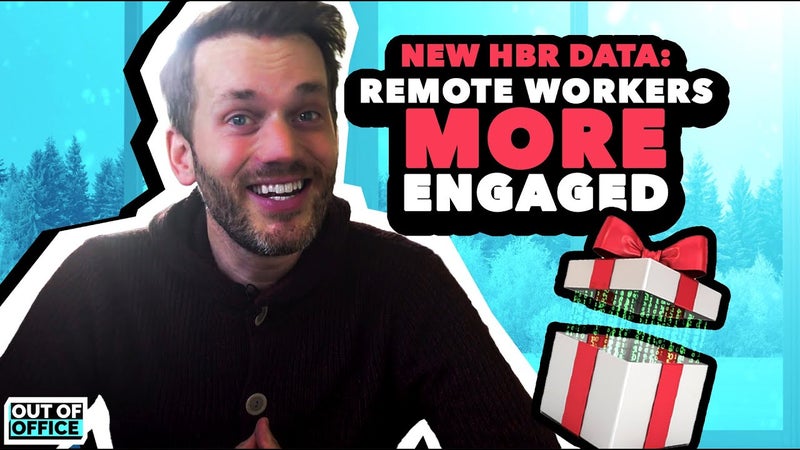Contents
- Hey! Christmas is Nearly Here –
- HBR: Remote Employees Are More Engaged
- HBR Survey Facts
- Santa: Who Decided Collaboration = Meetings?
- A Personal Note from Me: Happy Holidays
- This Week’s Shareable
- Latest Remote Jobs
Actual proof from a top US university that engagement increases with remote work.
👨🏫 HBR: The 2022 remote work survey
🤶 WTF: Who decided collaboration = meetings?
👱🏻♂️ Happy holidays: A personal note from me
Hey! Christmas is Nearly Here –
This week on episode 17, I’m working through the holidays to bring you the latest news on year-end data analysis. No, not your Spotify wrapped data – something a little more useful than that!
Harvard Business Review has just released a powerful crop of intriguing insights about remote work. So, I’ve launched myself into the data to bring you key highlights and takeaways for 2023.
Here’s what I found –
HBR: Remote Employees Are More Engaged
If you’re a regular here, you’ll know that there’s a remote work myth that is a huge pet peeve for me. It’s the one about remote workers being lazy.
This past year the myth only intensified, as concepts like quiet quitting turned up the heat on rumors that were already simmering in the media.
So recently Harvard Business Review asked the big question:
Do remote workers become less engaged over time?
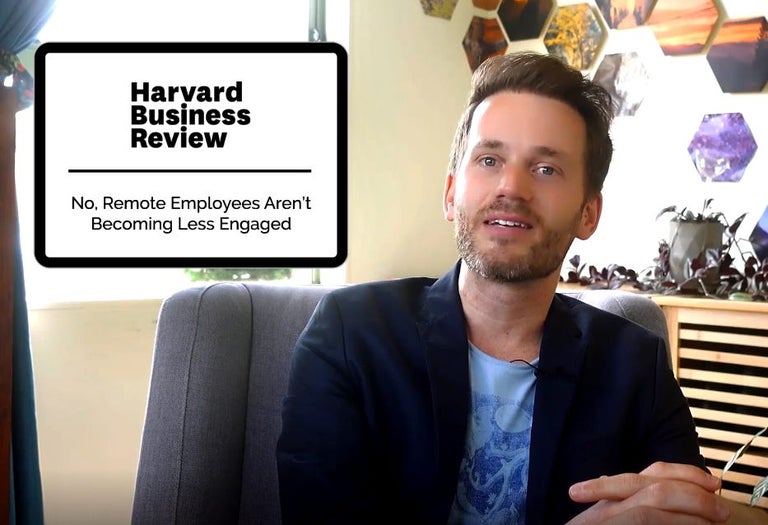
That’s an incredibly important question. CEO’s love to claim that ‘return to office’ is necessary because teams collaborate better in person…but do they?
Andrew Brodsky and Mike Tolliver teamed up to figure it out for themselves.
“We had originally predicted that one of the easiest ways to observe this effect would be a continual decrease in the number of times remote or hybrid coworkers were engaging — or meeting — with each other. However, we found quite the opposite.”
They scraped data from every Zoom, Teams and Webex meeting at 10 companies across multiple industries. Seven of those companies were Fortune 500 firms.
They compared six weeks in peak 2020 lockdown, with the same six weeks in 2022.
If you think counting meetings is a terrible way to measure collaboration (you’re right and I’ll tell you why later) but stay with me. This research identified 5 major ways remote collaboration has changed these past 2 years.
🚨 Spoiler alert!
Every single data point proves remote employees are becoming more engaged, not less.
HBR Survey Facts
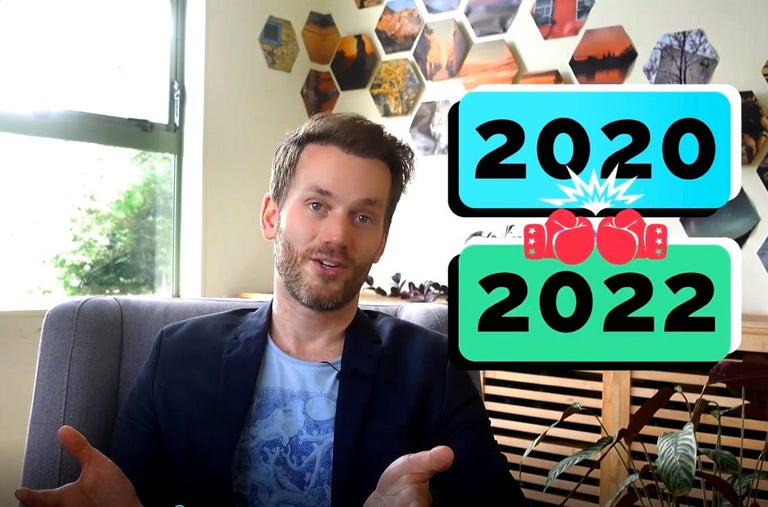
1️⃣: There are 60% more remote meetings happening now
In 2022, that’s an extra 5-8 remote meetings per employee than in 2020. Even though loads of businesses were hybrid this year, and in-person meetings weren’t counted.
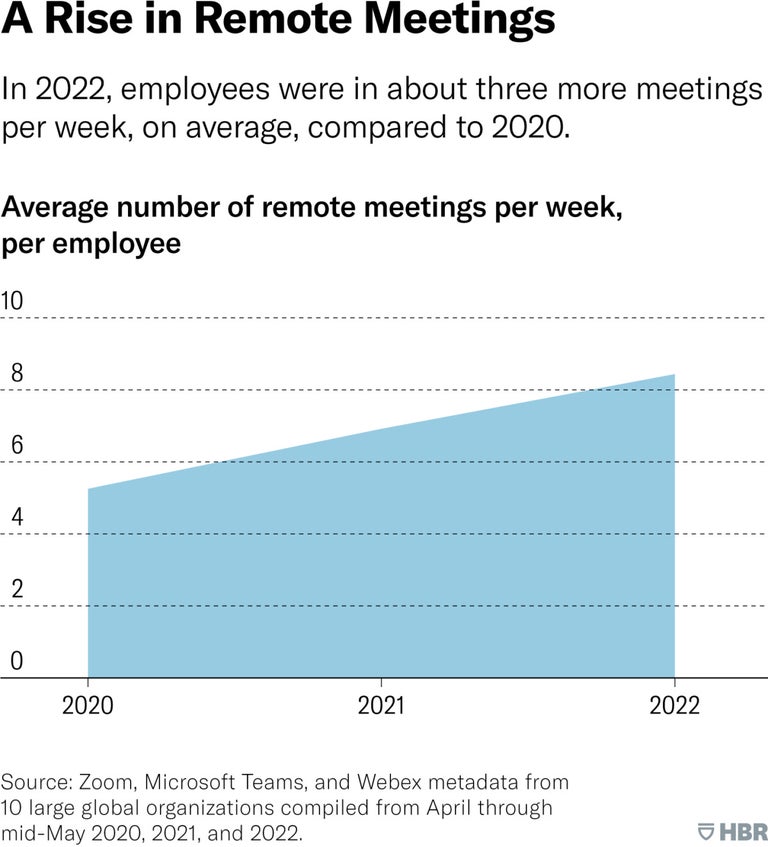
2️⃣: Remote meetings are 25% shorter
Meeting times have dropped, from 43 minutes in 2020 to 33 minutes in 2022.
👩💼 Looks like Susan from Finance has finally figured out how to share her screen without calling tech support.
3️⃣: Remote meeting participants have halved
Less people are part of remote meetings now, dropping from 20 to 10 in 2022. While Elon Musk caps meetings at 6 people, this particular drop is because 1:1 meetings have increased by 43%.
4️⃣: 66% of 1:1 remote meetings weren’t scheduled
It’s true – remote meetings in 2022 were more spontaneous. It’s a huge uptick from 17% two years ago.
This is the kind of insight I find most interesting, because it mirrors the speedy and productive interactions that some feared would go extinct without office work.
🦖 But life finds a way!
5️⃣: In both years 6% of people left the organization
During the research period, 6% of ‘leavers’ did the exact opposite of the above four trends. Defined as people who either quit or were fired, these leavers had less interaction across the board.
This is the closest thing I’ve ever seen to actual data on quiet quitting. It proves that a reduction in collaboration is a major warning sign that someone’s leaving.
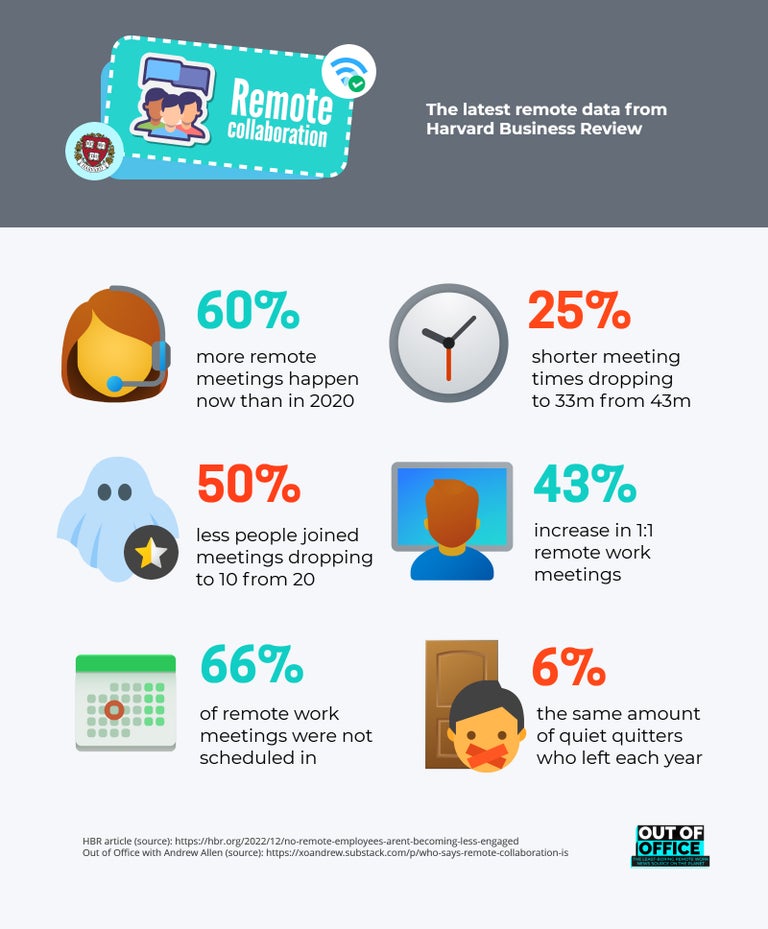
Here’s a nice infographic of the HBR data - go ahead and share it!
Santa: Who Decided Collaboration = Meetings?
Now to my biggest issue with quiet quitting and this HBR survey.
I’ve said it before and here it is again – quiet quitting is not a remote work issue. People in offices have been disengaging since time began.
The only thing that’s changed is we like to group things together under catchy titles that are ultra-newsworthy.
As for the HBR survey – the data is interesting, but I can’t believe the writers used such a reductive data set.
🦌🛷 Was it Santa that decided the best way to measure collaboration was by counting meetings?
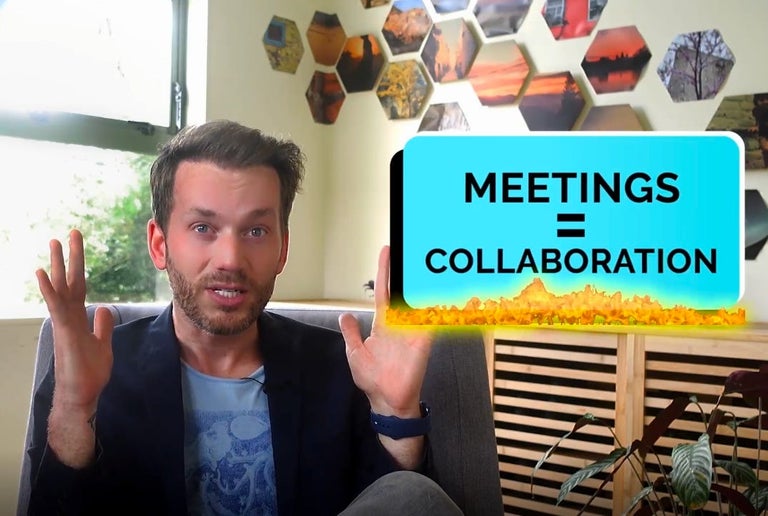
I know that collaboration is a tough thing to measure at scale.
It might be impossible, which is why this survey has some merit. But that doesn’t excuse the present-day reality.
We have a lot of other forms of collaboration happening in 2022. Counting meetings and calling it a day is problematic. For all of us.
🎭 Look, the writers do point out that it’s possible that some of the meetings are nothing more than productivity theatre – where people show up to look busy.
But they don’t consider that the most productive people of all could be the ones with the ‘least’ meetings.
That truly productive companies are the ones that give their people enough freedom to do their job – instead of talk about doing their job, in meetings.
This year I was most productive when:
- Collaborating via recorded Loom videos
- Commenting back and forth in Google doc threads
Those can be threaded by topic, edited with fresh info later, and used to follow-up and resolve outstanding actions. Find me a meeting that can do that!
Because both of those forms of collaboration are asynchronous, they don’t interrupt my train of thought when I’m doing deep work.
❄️ After all, I heard somewhere that a silent night is a holy night, and when all is calm, you can actually do your job.
This holiday season, take a page out of Elon’s book and cancel every unnecessary meeting. Your 2023 will be a lot brighter, and I’ll bet the presents under my tree that you’ll also be more productive and no less engaged.
A Personal Note from Me: Happy Holidays
As we all take time to reflect on this past year, I want to thank you for being here.
Because you’ve been tuning-in to Out of Office for 17 weeks now, we’ve reached over 2.5 million people! Clearly there’s demand for news about the future of work that’s anything but boring.

I’m so glad that you’re with us and I want to wish you and yours extra happy holidays from the team here at OOO.
🥂 We can’t wait to bring you more episodes in the lead up to 2023, and beyond.
And if you’re feeling generous (or you’ve already got into the eggnog and brandy pudding) – go ahead and share OOO with your friends, or drop me a line in the comments.
I want to know - do you think an avalanche of meetings correlates with great collaboration?
In the meantime, I’ll make sure OOO continues to be the gift that keeps on giving.
That’s it for this week, and remember – the future of work is Out of Office.
Andrew
This Week’s Shareable
- Did you know that 66% of 1:1 meetings in 2022 weren’t scheduled? The verdict is in - remote collaboration makes employees MORE engaged, not less. Hear about it on Out of Office this week, as we explore results from HBR’s new #remotework survey. #remotecollaboration
Latest Remote Jobs
Do you see your future here? Apply to one of these hot jobs!
💥 Student Analyst (Statistics) at gt.school / $60k ($30/hour)
💥 Presales Engineer at GFI Software / $100k ($50/hour)
💥 Senior Sales Engineer at Totogi / $200K ($100/hour)
💥 SVP of Commercial Product Management at IgniteTech / $400k ($200/hour)


